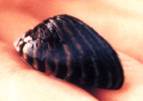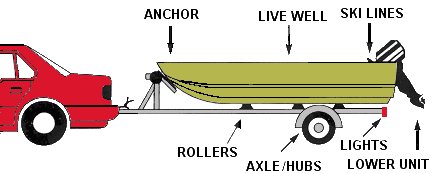Aquatic Nuisance Species
Alien Species

Chances are, no matter where you are in the country, you’ve heard of a local problem with a non-native plant or animal species that has been introduced into your local environment. Who hasn't heard of at least one of the following: zebra mussels--like the one pictured on the right, carp, kudzu, snakehead fish, European green crab, or lampreys.
These alien species can wreak havoc on the natural balance of our waterways. While zebra mussels may appear to be cleaning up the Great Lakes (the water is much clearer than in years past) there are monumental negative implications of these mussels being there. And like many species that are not native, they are easily transported to new areas, and highly adaptable to new climates.
As boaters, we have an important role to play in NOT transporting species from one body of water to another. Experts predict that many aquatic nuisance species (ANS) will spread because of actions taken by un-informed people, and by trailered boats going from one lake to another, or from a lake to a river.
Almost every area of the country has specific nuisance species concerns that can be found on the internet. Visit the ANS Task Force for the latest information on various alien species.
Minimize the Risk
Here are some basic ideas that every boater needs to know in order to minimize the risk of being the carrier of ANS to a new waterway:
- If you are moving your boat from one water body to another, you are a potential carrier of plants and animals to the next waterway. Heads-up!
- Both big boats and small boats can be the carrier of ANS.
- Many ANS (like zebra mussels) can be transported in water, on equipment, the trailer, or on the boat. In their juvenile stage, you will not even be able to see them.
- If you have visible growth on the side of your boat you should double check that these are not ANS – contact your state Sea Grant or US Fish and Wildlife Agent if you have any doubts. Moving ANS from one state to another is not only really stupid, it’s against the law.
- If you are boating in an area where ANS are known to live, you should be especially careful about cleaning your boat off before taking it to a new waterway.
At any waterbody, if you have a small trailered boat, and have just pulled the boat out of the water but are still at the ramp, here are some things to check.

- Pull all plants or plant fragments off. Check the rollers to make sure there aren't any plants between the boat and the roller or the pads. Make sure your engine doesn't have any plants in the propeller.
- Empty all water from the boat, the live well, the bilge, and the bait bucket.
- Dump all unused bait at the fishing site, or give it to someone else who might be fishing.
- Wash off your boat, your ski lines, your gear, your engine, and scrub with a disposable rag. Leave the rag in the garbage can at the ramp.
- The overall idea with this cleaning process is to leave all plants and animals at the ramp, instead of moving any of them to another area of water or taking them home accidentally.
ONE FINAL NOTE:
Plants, fish, insects and animals from home aquariums should not be disposed of in lakes or anywhere in the natural environment. Many of these species are NOT native, and can destroy our local waterways.

